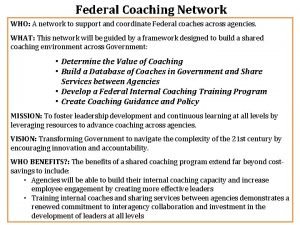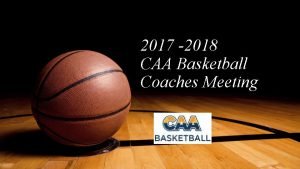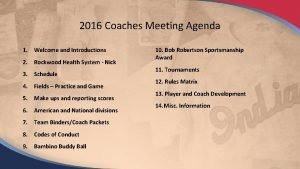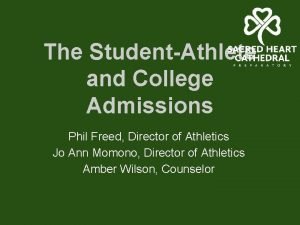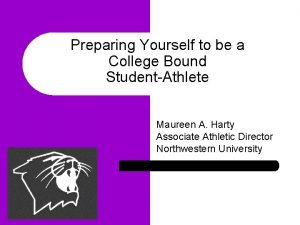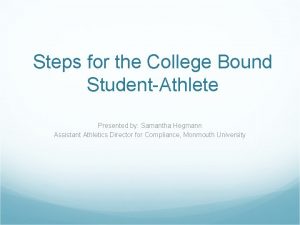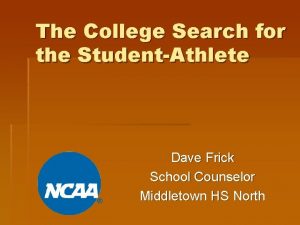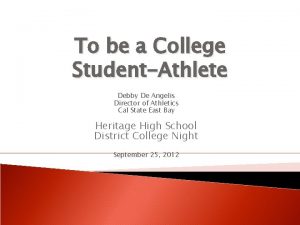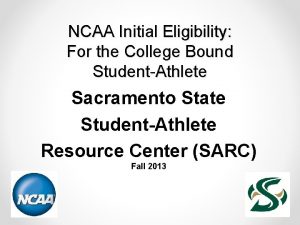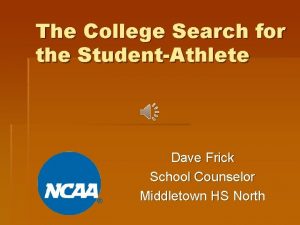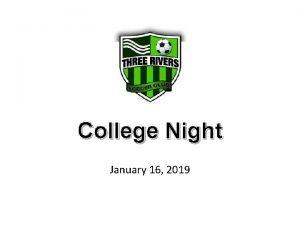COLLEGE NIGHT FOR COACHES HOW THE SUCCESSFUL STUDENTATHLETE















- Slides: 15

COLLEGE NIGHT FOR COACHES HOW THE SUCCESSFUL STUDENT-ATHLETE SCORES

Know your Student-Athletes Know the Chances Know the Options Know the Requirements Start Early Know the Steps

S KNOW YOUR PROSPECTIVE STUDENT-ATHLETES (PSAS) • How significant is the pursuit of their sport to their overall choices about college? • What is their level of talent? • What is their tolerance/desire for academic rigor? • What size of school/geography/choice of major appeals to them? • What are their test scores/grades? • What are their other interests?

C KNOW THE CHANCES • Of nearly 8 million high school athletes, 3 -12% (an average of 7. 9%*) will play any level of college athletics (percentages vary by sport). • Only 2% receive any athletic scholarship support; fewer than 1% receive full scholarships (average is ≈ $12, 000). *Not counting women’s ice hockey (24. 1%)

C KNOW THE CHANCES

C KNOW THE CHANCES • Different sports have different numbers of scholarships available, and not all programs are fully funded. • Scholarship limits are annual and apply to the whole team. PSAs interested in a particular 4 -year school are competing for just 25% of that school’s maximum available scholarship money for their year of enrollment. • Even D-I “headcount” sports (where scholarships are full or none) may maximize their budgets by offering to pay for fewer than 4 years. • Spot on the Roster ≠ Scholarship ≠ Free College

O KNOW THE OPTIONS & OPPORTUNITIES • NCAA Divisions I, III Varsity • NCAA Divisions II, III Junior Varsity (includes some D-I’s: The University of North Carolina at Chapel Hill Tar Heels Men’s Basketball even has a JV) • NAIA (Varsity and JV) • NJCAA (Varsity and JV) • Club Sports • Intramural Sports

R KNOW THE REQUIREMENTS • All eligibility requirements are not equal. • A PSA considering both NCAA D-1 and D-II options, or both NCAA D-III and NAIA options, must know and meet the requirements of each. • Being NCAA-eligible does not mean a PSA will meet minimum requirements at each school of interest (especially at more selective schools). Know the requirements of each school of interest. • Students should register with NCAA/NAIA clearinghouses in their sophomore years.

E START EARLY • Once PSAs know the requirements of getting into school(s) where they might like to play a sport, this information can and should inform the classes they take in high school. • Encourage PSAs to let school counselors know their intentions when they are freshmen (or sophomores at the latest), so counselors can help guide course selection. • Encourage PSAs to prepare for and take college entrance exams as early as possible; scores will become part of their clearinghouse profile(s). • Hold PSAs to standards that will help them maintain their eligibility.

E START EARLY • Depending on a PSA’s sport and/or their level of interest (especially competitive D-I conferences), recruiting may begin as early as 8 th grade. • Small programs and/or programs at lower levels may begin looking at PSAs during their sophomore-junior seasons. • About 10% of college student-athletes don’t stay at their schools or on their teams beyond their freshman year. Transfers create a few opportunities for uncommitted juniors and seniors, even in bigger programs. • Smaller schools may wait until late in the game to fill their rosters. PSAs should make sure late-coming schools are right for them outside of athletics.

E START EARLY • While college fit is as important as athletic program fit, PSAs must be willing and able, and have the tools necessary to market themselves athletically. • Freshmen-sophomores should be taking video, writing resumes, creating websites, and refining lists of schools whose coaches they want to contact. • Sophomores-juniors should be emailing and/or calling coaches at schools of interest, and if possible, visiting campuses. • Help PSAs understand what things you can help with and what things they should do for themselves. Also make sure you and the PSA understand NCAA/NAIA/NJCAA recruiting/contact guidelines.

S KNOW THE STEPS • The most successful PSAs lead their own college searches; after all, who knows them better? Encourage PSAs to take initiative in finding a college that meets all their needs. • Be encouraging, and help PSAs understand your role. A huge misconception is that “my coach will get me a scholarship. ” • Even the best connected coaches may know fewer than 100 college coaches (most may know only 5 -10). Understand that your PSA’s best college fit will likely be outside of your circle, and help PSAs understand that as well. • If a PSA’s best fit schools are outside your circle, be willing to reach out to new schools on your PSA’s behalf.

SOME NOTES ON COLLEGE FIT • Help PSAs understand the commitment inherent to playing college sports. • How much do they want to be part of a college athletics program? How much do they want to experience everything else college has to offer? • Encourage PSAs to find their best fit: where would you want to be if you got hurt and couldn’t play?

SOME NOTES ON COLLEGE FIT • Successful PSAs will attend the school that is the best fit for them in all ways: the right classes, climate, campus, nearness to home, and the right coaches and athletic competition. • If a school doesn’t meet all their needs, PSAs may be unlikely to stay for all four years, even if the initial athletic fit is good. • Coaches leave. Injuries happen. A good college fit can help PSAs overcome these obstacles. Help PSAs remember that the prize is a college education at a school they love.

SOME NOTES ON COLLEGE FIT • A target list can subsequently help PSAs and their coaches decide which college programs to concentrate on. • Identifying a list of target schools based on academic, social, and other considerations may be done with the help of an Independent Educational Consultant (IEC).
 Federal coaches
Federal coaches Texas cross country coaches association
Texas cross country coaches association Newington little league baseball
Newington little league baseball High school coaches meeting agenda
High school coaches meeting agenda Football meeting agenda
Football meeting agenda Ice skating whitley bay
Ice skating whitley bay Basketball coaches meeting agenda
Basketball coaches meeting agenda Strategic conservation planning
Strategic conservation planning Julius campbell
Julius campbell Psa my sam login
Psa my sam login Commercial law outline
Commercial law outline Top 10 seo coaches
Top 10 seo coaches Conservation coaches network
Conservation coaches network Basketball parent meeting agenda
Basketball parent meeting agenda Kentucky high school golf coaches association
Kentucky high school golf coaches association Cobb & co coaches
Cobb & co coaches
